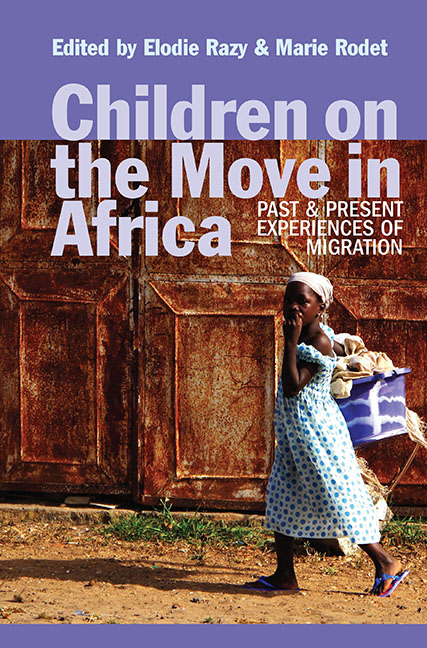Book contents
- Frontmatter
- Contents
- List of Illustrations
- Notes on Contributors
- Preface
- Acknowledgements
- Introduction: Child Migration in Africa: Key Issues & New Perspectives
- Part I CHILD MIGRANTS IN AFRICA: BEYOND THE DILEMMA OF VULNERABILITY v. AGENCY
- 1. ‘An Ardent Desire to be Useful’: Senegalese Students, Religious Sisters & Migration for Schooling in France, 1824–1842
- 2. Girl Pawns, Brides & Slaves: Child Trafficking in Southeastern Nigeria, 1920s
- Part II BEING A CHILD & BECOMING A GENDERED ADULT: THE CHALLENGES OF MIGRATIONS IN CHILDHOOD
- Part III MOBILITY, IMAGINATION & MAKING NATIONS
- Bibliography
- Index
2. - Girl Pawns, Brides & Slaves: Child Trafficking in Southeastern Nigeria, 1920s
from Part I - CHILD MIGRANTS IN AFRICA: BEYOND THE DILEMMA OF VULNERABILITY v. AGENCY
Published online by Cambridge University Press: 25 October 2017
- Frontmatter
- Contents
- List of Illustrations
- Notes on Contributors
- Preface
- Acknowledgements
- Introduction: Child Migration in Africa: Key Issues & New Perspectives
- Part I CHILD MIGRANTS IN AFRICA: BEYOND THE DILEMMA OF VULNERABILITY v. AGENCY
- 1. ‘An Ardent Desire to be Useful’: Senegalese Students, Religious Sisters & Migration for Schooling in France, 1824–1842
- 2. Girl Pawns, Brides & Slaves: Child Trafficking in Southeastern Nigeria, 1920s
- Part II BEING A CHILD & BECOMING A GENDERED ADULT: THE CHALLENGES OF MIGRATIONS IN CHILDHOOD
- Part III MOBILITY, IMAGINATION & MAKING NATIONS
- Bibliography
- Index
Summary
The commission has undertaken to get the facts about the traffic in women and children as it exists to-day over the world.
(William F. Snow, Chief of the Advisory Committee on the Traffic in Women and Children, 1926)Child trafficking and migration often results from economic and resource insecurity. Sub-Saharan Africa is credited with the largest number of trafficking victims overall, with two-thirds of those trafficked identified as children. In particular, the movement of children under various forms of guardianship is on the rise and this phenomenon has become an urgent international concern. Benjamin N. Lawrance and Richard L. Roberts suggest that child trafficking must be considered in relation to how colonization related to the global economy. It is nearly impossible to address contemporary concerns about the welfare of trafficked children without taking into consideration the historical context in which the transfer of children under various forms of guardianship became normalized. Scholars and policy makers can best understand the contemporary problems of child trafficking in West Africa (and abroad) by tracing its historical development from the transatlantic slave trade to colonial forms of servitude and beyond.
By piecing together colonial reports, oral interviews, antislavery archival materials, League of Nations documents and anthropologist and missionary memoirs, this chapter aims to show that the trafficking of women and children was complex and deeply embedded in Nigerian economic systems. With a specific focus on Igbo, Ibibio, Ijaw (Ijo) and Efik communities during the colonial period, I have encountered rich details about the transfer of children, mainly girls, from one form of guardianship to another. Yet, even with this diverse set of resources, child trafficking cases remain impossible to quantify. Moreover, independent accounts from child brides, pawns and slaves are also missing. These details would have enhanced the understanding of such exchanges. Similar to what Sacha Hepburn argues with regard to girls in post-colonial Zambia and Paola Porcelli's analysis of child fosterage in rural Mali, Southeastern Nigerian children filled a variety of labour and economic needs by virtue of being transferable.
- Type
- Chapter
- Information
- Children on the Move in AfricaPast and Present Experiences of Migration, pp. 51 - 66Publisher: Boydell & BrewerPrint publication year: 2016



